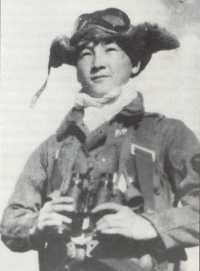
HOME > JAPAN > KAWATO
The man who didn't shoot down Pappy Boyington
The following is adapted from Henry Sakaida's Pacific Air Combat WWII--Voices From the Past which alas is out of print, though used copies may be available from Amazo.com. Henry was a Californian who learned Japanese so that he could research the "winged samurai" of the Pacific War. He also wrote The Siege of Rabaul, which is the basis of another page on this site. In Pacific Air Combat, he sets out to recreate famous or obscure air battles from the points of view of both combatants, the Allied fliers and the Japanese who opposed them. It's a remarkable book though not particularly well presented--a large-format paperback with the type set in two columns, magazine-fashion.
Kawato Masajiro (family name first, in the Japanese style) was
born in 1925 to a farming family on Honshu, the main island. He
finished the traditional eight years of public school and became
a navy flight cadet in 1942. If he looks boyish in the photo at
left--well, he was a boy. Eighteen years old, he was one of 45 newly-minted fighter
pilots who set out for the Pacific island of Truk in September
1943. There each was assigned a Zero fighter and sent on to his
final destination, which in Kawato's case was Rabaul, on the
island of New Britain. Kawato was a petty officer 3rd class, the
equivalent of a corporal or buck sergeant in U.S. Army service.
He was a member of Air Group 253.
In 1956, Kawato published a memoir called Zero-Sen Rabaul Ni Ari, a cheap paperback that made many extravagant claims for his wartime exploits but makes no mention of Greg Boyington.
Twenty years later, Kawato came to the United States and was introduced to Greg Boyington, who at that time was busily involved as technical adviser to the TV series "Black Sheep." Kawato was asked if he had ever heard of Boyington or the Black Sheep Squadron; he said he had not. Boyington gave him a copy of his own book, and Kawato telephoned him shortly thereafter to say that, after reading Boyington's account of the shoot-down, he had concluded that he was the Zero pilot responsible.
Zero-Sen Rabaul Ni Ari was translated into English in 1978 as Flight Into Conquest (used copies may be available at Amazon). It's the same book, Henry says, yet miraculously it has sprouted new material on how he bested one of America's most famous pilots. Indeed, it has an artist's rendering of Kawato's Zero in combat with Boyington's Corsair with fuselage number 86 (which wasn't flown that day by Boyington). As he now told the story, Kawato spotted the Corsair over Duke of York Island, being chased by several other Zeros.
"I kept my cool and waited until I had the right distance. After 15 or 16 rounds of 20 mm gunfire, some hitting the cabin near the cockpit, it started to smoke a little, but no flames. He rolled over to the right and went into a dive, but I was able to stay with him.... As he was going over Rabaul where our base was located, I was thinking how far this Corsair (F4U) would be able to escape me."
Interviewed later by Henry Sakaida, Boyington scoffed at this account. He was nowhere near Duke of York or Rabaul itself; he had used the term "Rabaul" in his book, as the Marine pilots did, to refer to the general area, not necessarily to the port itself.
Boyington was lost on January 3, 1944, near the island of New Ireland. Henry found that Kawato did indeed fly that day, in a 37-Zero effort led by Lt. Nakagawa Kenji. Along with 33 Zeros from Air Group 204, they engaged what they believed were about 30 Corsairs in a battle that lasted 35 minutes--an eternity in fighter-pilot time.
All combat claims are apt to be exaggerated, and Japanese claims are more inflated than most, since there was no "ace" tradition and therefore no rigorous examination of what pilots reported after the fact. On the day Pappy Boyington went into the water, the claims were fairly modest: Air Group 253 credited with 5 Corsairs shot down, Air Group 204 with 3 Corsairs and 1 Hellcat. Actually American losses were two, the Corsairs flown by Boyington and his wingman, Capt. George Ashmun.
As for Kawato's claim, Henry got this statement from the former president of the Japanese Defense Agency: "Kawato Masajiro piloted the third aircraft in a formation of four, and his assigned duty was to fly protective cover for the Japanese pilots actually engaged in the aerial combat in which Major G. Boyington was downed. Kawato Masajiro had a reputation among his fellow pilots as having plenty of guts. His courage in combat is not in question, but in so far as the battle of January 3, 1944 is concerned, his claim for credit is groundless and without a basis in fact."
It wasn't only the Boyington shoot-down that Kawato apparently lied about. Henry goes through his other claims in great detail, and many of them have the same inconsistencies and impossibilities. The same was true of other details of Kawato's World War II experiences. He evidently was a natural-born fabricator.
Other files about Pappy Boyington:
- Boyington's thoughts about the Brewster Buffalo
- Black Sheep One: The Life of Gregory "Pappy" Boyington
- Boyington's combat claims revisited
- Greg Boyington, Flying Tiger

Question? Comment? Newsletter? Send me an email. Blue skies! -- Dan Ford
Other sites: Flying Tigers: the book | Daniel Ford's blog | Daniel Ford's books | Facebook | Piper Cub Forum | Raintree County | Reading Proust | Expedition Yacht Seal
Posted February 2016. Websites © 1997-2016 Daniel Ford; all rights reserved.